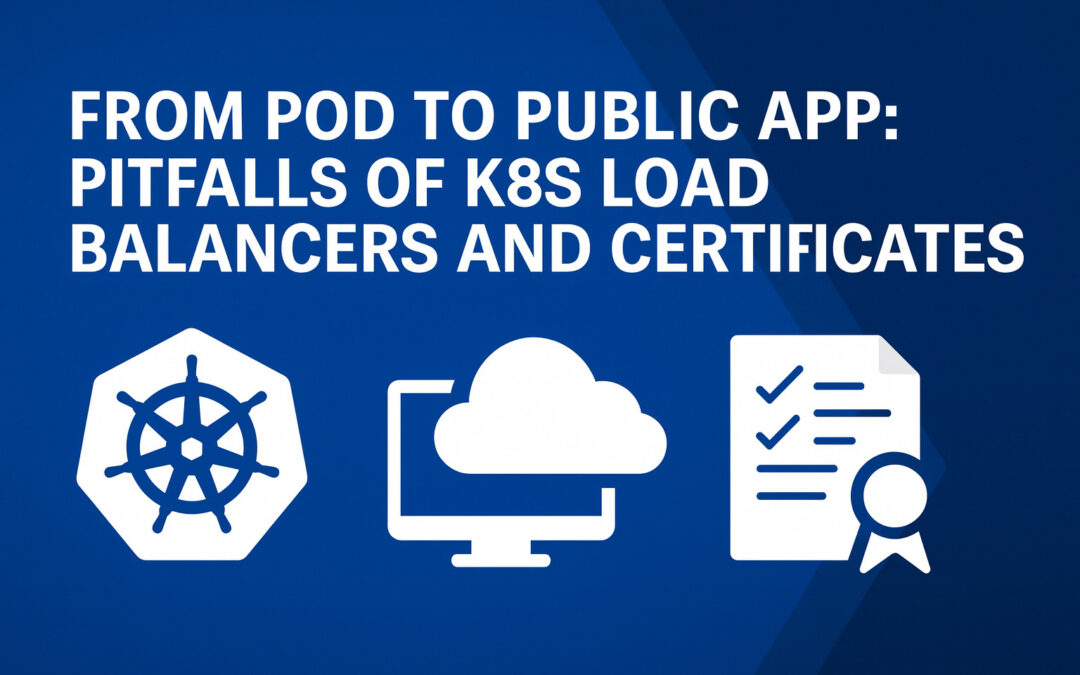Shipping a Python application is easy — until you run it in production on a hyperscaler with Kubernetes in the middle. Suddenly, the code that happily ran in your venv is only the smallest piece of the puzzle. The real battles happen elsewhere: service types, port management, ingress controllers, load balancers, TLS certificates. If you’ve been there, you know — the devil lives in the details.
This article breaks down the most common pitfalls that teams hit when running Python apps in real-world Kubernetes setups on AWS, GCP, Azure & friends.
1. Service Type Confusion
Kubernetes gives you options (ClusterIP, NodePort, LoadBalancer), but the meaning shifts once a hyperscaler takes over.
- ClusterIP works only inside the cluster. Great for inter-service traffic, but useless for anything “public.”
- NodePort sounds tempting: a port exposed on every node. In practice, it’s a maintenance nightmare — brittle firewall configs, awkward port ranges, and traffic never balancing evenly.
- LoadBalancer is the default for going public, but here’s the catch: every cloud provider wires this differently. AWS might spin up an NLB, Azure sneaks in an SLB, GCP rolls out its own magic. The side effects? Unexpected costs, strange timeouts, or “helpful” health checks you never asked for.
👉 Rule of thumb: Always map your service type to the actual load balancer implementation in your provider. Otherwise, you’ll spend more time debugging traffic flows than running Python code.
2. Port Management Madness
Python apps (Flask, FastAPI, Django, etc.) typically default to port 8000. No problem locally — but in Kubernetes:
- Containers listen on one port.
- Services translate between targetPort, port, and nodePort.
- Load balancers might re-map them yet again.
Result: you think your app runs on 443, but internally it bounces 443 → 80 → 8000. One wrong mapping and the connection dies silently.
👉 Best practice: Standardize. Pick one internal container port (8000 or 8080) and never deviate. Let the service and ingress do the translation. Document this once — or your future self will curse you.
3. The Ingress Controller Trap
Ingress controllers promise simplicity (“just add an annotation!”) but hide a world of complexity:
- Nginx ingress: battle-tested, but annotation sprawl can get ridiculous.
- Traefik: slick, but requires a mindset shift (CRDs everywhere).
- Cloud-native ingress (e.g., GKE Ingress, AWS ALB Ingress): feels integrated, but locks you into provider-specific quirks.
The biggest mistake? Mixing them. I’ve seen teams run Nginx ingress and a cloud-native ingress at the same time, fighting over the same domain. Result: race conditions, duplicate DNS entries, and certificates never attaching correctly.
👉 Rule: One ingress controller per cluster. If you need more, you probably need a multi-cluster design instead.
4. Certificates and TLS – Death by a Thousand Cuts
Let’s Encrypt sounded like the solution to everything. Then you hit Kubernetes reality:
- Cert-manager requires RBAC tuned just right, or renewals silently fail.
- Cloud provider-managed certs don’t integrate cleanly with your ingress.
- Wildcards are often blocked or require manual DNS tweaks.
Worst case: your production API dies on a Sunday because a certificate expired, and you didn’t notice the renewal job failing.
👉 Survival tip: Automate and monitor. Never trust that certificates “just renew.” Hook certificate validity into your alerting system.
5. ClickOps vs. Engineering
This one is cultural, but deadly: relying on cloud consoles.
- It’s easy to tweak a load balancer setting in AWS Console.
- It’s easy to click “enable TLS” in GCP.
- It’s easy to “just fix it” manually in Azure.
The cost: six months later, nobody knows why one cluster works differently than the other. Your infrastructure is now a black box of random human clicks.
👉 The only cure: IaC (Infrastructure as Code). Terraform, Pulumi, Helm — doesn’t matter. But everything must be in code. Your Python app deserves an infrastructure that’s reproducible, not a Jenga tower of console tweaks.
6. Debugging: Where the Real Work Happens
When Python logs stop, where do you look? The stack is deep:
- Pod logs (maybe the container died).
- Service endpoints (maybe kube-proxy never updated).
- Ingress logs (maybe the request never left the load balancer).
- Cloud provider health checks (maybe traffic never hit Kubernetes at all).
Each layer can fail independently, and you’ll spend hours proving it’s not your Python code.
👉 Golden rule: Always have tracing visibility from ingress down to the pod. Tools like OpenTelemetry, Jaeger, or even structured JSON logs piped into Loki/Grafana are your best friend.
From Engineering Partner, Not a “Freelancer-for-Hire”
I don’t parachute in as a ticket-solving freelancer who just clicks around until the error disappears. I partner with teams end-to-end:
- Architecture decisions before the first cluster is created.
- Deployment pipelines that actually deliver, not just “worked on my laptop.”
- Debug sessions where we trace packets, not vibes.
Output-focused. No half-baked ClickOps. That’s how you survive — and thrive — when running Python apps at scale on hyperscalers.
🔥 TL;DR: Running Python apps on Kubernetes across AWS, GCP, Azure sounds boring until you hit production. Then you learn: service types bite, ports misalign, ingress controllers fight, certs expire, and consoles tempt you into chaos. Get it right early — or spend weekends firefighting.
